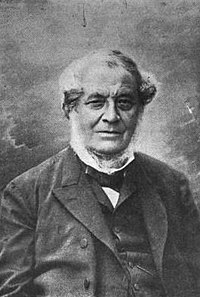This bad boy explosion isn't just from any old bomb, this is a goddamn atomic bomb. In fact this is the first human engineered nuclear explosion. The Manhattan Project was a top secret coalition between the U.S. Canada and Britain to create the first nuclear explosives. Started in 1942 and ending in 1946 this program would eventually dole out the "Fat Man" and the "Little Boy", the two nuclear ordnances that found their way to the mainland of Japan during World War II. These two bombs were respectively made of plutonium and uranium isotopes. Do you think this program was created for the greater good or was it a terrible use of human innovation?
These bros seemed like they were fine with their decision.. one that would ultimately cost thousands of lives.
Monday, April 4, 2011
Thursday, March 31, 2011
Happy Birthday Bunsen!
If you went over to google today you would have seen the picture of test tubes and flames and chemistry accessories. That's because today is Robert Bunsen's 200th birthday! He was a German chemist and is most famous for developing the bunsen burner. Just look at him, he is a total badass.
Saturday, March 26, 2011
Do you own a Blackberry?
http://thebrowser.com/videos/my-blackberry-isnt-working
This video accurately describes my relationship with blackberry products.
This video accurately describes my relationship with blackberry products.
Thursday, March 24, 2011
Tuesday, March 22, 2011
Dem Molecules
A molecule is an electrically neutral group of at least two atoms held together bycovalent chemical bonds. Molecules are distinguished from ions by their electrical charge. However, in quantum physics, organic chemistry, and biochemistry, the term molecule is often used less strictly and applied to polyatomic ions.
In the kinetic theory of gases, the term molecule is often used for any gaseous particle regardless of its composition. According to this definition noble gas atoms are considered molecules despite the fact that they are composed of a single non-bonded atom.
A molecule may consist of atoms of a single chemical element, as with oxygen (O2), or of different elements, as with water (H2O). Atoms and complexes connected by non-covalent bonds such as hydrogen bonds or ionic bonds are generally not considered single molecules.
Molecules as components of matter are common in organic substances (and therefore biochemistry). They also make up most of the oceans and atmosphere. A large number of familiar solid substances, however, including most of the minerals that make up the crust, mantle, and core of the Earth itself, contain many chemical bonds, but are not made of identifiable molecules. No typical molecule can be defined for ionic crystals (salts) and covalent crystals (network solids), although these are often composed of repeating unit cells that extend either in a plane (such as in graphene) or three-dimensionally (such as in diamond or sodium chloride). The theme of repeated unit-cellular-structure also holds for most condensed phases with metallic bonding. In glasses (solids that exist in a vitreous disordered state), atoms may also be held together by chemical bonds without any definable molecule, but also without any of the regularity of repeating units that characterises crystals.
Friday, March 18, 2011
HONClBrIF
Diatomic Molecules = Epic
H= Hydrogen
O= Oxygen
N= Nitrogen
Cl= Chlorine
Br= Bromine
I= Iodine
F= Fluorine
H= Hydrogen
O= Oxygen
N= Nitrogen
Cl= Chlorine
Br= Bromine
I= Iodine
F= Fluorine
Subscribe to:
Posts (Atom)


